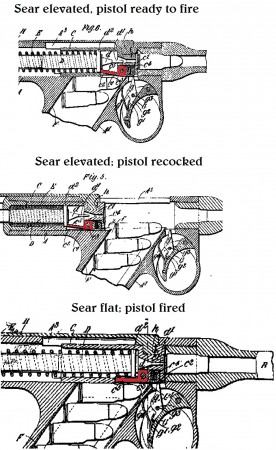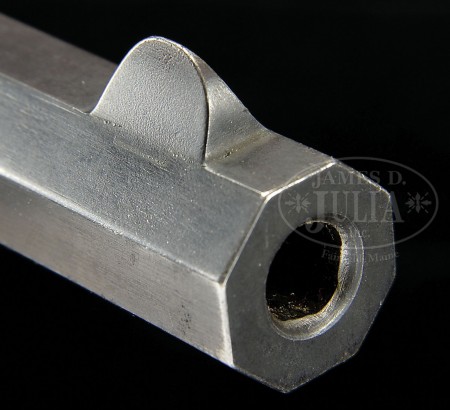We all know of Hiram Maxim for his groundbreaking work in machine gun development – but not many people are familiar with his automatic pistol designs. In fact, this is at least partly because the designs were not exclusively his – the pistol we are going to look at today is a design jointly patented by Maxim and one of his assistants, Louis Silverman. Silverman was one of the first people hired by Maxim when he began experimenting with firearms, and the man would eventually become a factory foreman in Maxim’s employ.
Maxim was a rather egotistical man, and not one interested in sharing credit or accolades. Anyone with a reasonable knowledge of Maxim’s character is left with little other conclusion but that any man Maxim would be willing to share a patent with must have contributed a very significant portion of the work involved, if not a majority of it. It is worth pointing out that these automatic pistol designs are mentioned nowhere in Maxim’s autobiography, and that at least one photo therein (of Maxim and Silverman helping future King Edward VII shoot an 1885 Maxim machine gun) was edited to remove Silverman’s appearance.
Anyway, before I lay too much criticism at Maxim’s feet, let’s take a look at this 1896 pistol design. FYI, the photographs in this article are all taken from the James D. Julia auction house, which is bringing one of the 3 existing such pistols up for sale…

Compared to virtually every other handgun in production in 1896, the design looks strikingly modern – anyone not familiar with it could probably be easily convinced that it was a prototype Ruger. It is also remarkably simple for such an early design. While most of the other handguns on the market were using complex locking mechanisms like the Borchardt’s toggle lock or the blocks and wedges of the Mannlicher and Mauser guns, the Maxim-Silverman was a simple blowback design. It used a single spring as both recoil spring and firing pin spring, with the firing pin cocking by inertia at the end of the recoil stroke. That is to say that the firing pin floated inside the bolt under pressure from the mainspring. Recoil would throw the bolt and firing pin backwards, and the firing pin would continue moving rearward after the bolt had stopped, thereby locking behind the sear and becoming ready to fire again once the bolt closed on a new cartridge. The spring-loaded sear was located on the bolt instead of the frame to accomplish this, one of the elements protected by the Maxim-Silverman patent:

Another clever element in the design was the use of a floating ejector, which was pushed out to eject a case by a cam in the back of the receiver. This was a novel idea at the time, and would later become quite common, especially on machine guns.

By this point, looking at the clever ideas embodied, one begins to wonder why there pistols didn’t become popular, and better known. It appears that the main reason lies in the inventors’ choice of ammunition. The first cartridge chosen appears to have been the 7.65mm Borchardt (one of the existing 3 examples is in this caliber), which was available at the time because of the C93 pistol. That cartridge, however, is rather overpowered for this blowback design. A second existing pistol (the one photographed here) is chambered for a unique cartridge which appears to by the Borchardt round necked up to .333 inch/8.45mm (R.K. Wilson misidentified this as 8mm Schonberger in his otherwise-excellent Textbook of Automatic Pistols). This larger bullet was no improvement for functioning. In fact, a modification was made to the design in an attempt to delay the bolt blowback, which is visible on the left side of the pistol. An opening was cut in the receiver, and a beveled cutout made in the side of the bolt. A matching beveled flat spring was screwed to the side of the gun, so that the bolt would have to force it out of the way before it could travel backwards, thus adding a significant amount of resistance to the action.


The third known existing example of the pistol is chambered for a .455 Webley cartridge and is a monster of a pistol, being both longer and heavier than a .450 caliber Mars automatic.


So, we can see that the initial patent design, while it had many clever and innovative elements, was unworkable in the caliber chosen. This would have been fixable as the added spring on this pistol shows (or by reducing the caliber and working to a civilian rather than military market), but something else was holding the pistol back. At the time he was working on the design (and really, it is more likely that Silverman was doing the brunt of the work), Maxim was tremendously preoccupied with development of his machine gun, and upcoming acquisition by the Vickers company. He likely chose not to allocate any serious resources to back the pistol development, and left it to die on the vine. Unfortunately for Silverman, it may well have been simple ego and jealousy that prevented this quite promising design from ever seeming production.

Before we conclude, we should take a further look at the Maxim-Silverman patent. It actually includes three different designs. The first is the pistol photographed here. which is the only one of the designs actually built. The second design appears to have been more Maxim’s idea than Silverman’s, as it shares a few basic elements but includes a number of fire control parts that look suspiciously like pieces of a Maxim machine gun lock. The third design is a variation of the first, and it contains the potential seed of another way to solve the pistol’s over-power problems: a lever-delaying system like that later patented by Király…

Who knows what might have changed if Silverman had been able to get a backer for his work…
Patents
Great Britain Patent #29836, year 1896.
Bibliography
Goldsmith, Dolf. The Devil’s Paintbrush: Sir Hiram Maxim’s Gun. Collector Grade Publications, 2002 Expanded Edition.
Sturgess, Dr. Geoffrey L. “Maxim’s Pistols”. Journal of the Historical Breechloading Smallarms Association, Volume 2 Number 6.

I love the look of this pistol, it has a very sleek look that is rare for such an early pistol.
In a different book article, the author claimed that they drilled a hole in the receiver to vent some of the chamber pressure to make it more compatible with the blowback action. He was from way back then and had several pictures of the three guns and had actually fired them. He complained about the grip angle and gas vent near his trigger finger, which is apparently visible in the pictures above? But they supposedly worked?
It was an old and expensive book to buy for my collection, but I’ll have a look for more info if you like.
I really like this pistol, it would be a great basis for a modern version I think.
It’s so sleek, slide pistols are ten a penny it’s about time someone made something else for a change.
One could perhaps use a type of Fedorov locking action, have a tubular sleeve about 1/2″ long wrap around the barrel forward of the chamber. And attach the locking pieces of said action on either side, fit a short spring forward of this sleeve around the barrel which would stop a ring formed from the barrel – So the spring pushes the sleeve rearward and thus the Fedorov locking pieces are in the open position, in conjunction with the frame corresponding to this design. Construct a bolt which operates as per the Fedorov but in this pistols configuration, then the bolts lugs will engage the locking pieces pivots – In the open position, when the bolt closes. The bolt having a stronger spring, this pushes the sleeve around the barrel forward therefore locking the bolt to the sleeve. And as the sleeve can’t move forward of the position aforesaid via a ring formed from the barrel at the chamber mouth, upon firing the bolt and sleeve would move back the appropriate distance to lower the lower pieces, then the bolt acts as per – on the return it functions as above might work… Definitely worth thinking about other designs, personally I am a bit tired of seeing the same things other, and other even if they work.
Over, even…
Think Ruger. The same constraints that prevent most Blowback operated pistols from chambering cartridges more powerful than the .380 ACP/9mm Kurtz stopped these guns from working right. If you want a sleek and “modern” looking hand gun, buy a gussied-up Ruger, or High-Standard .22, or best yet an old Automag 180.
How does it reset? How does the firing pin go behind the red lever after firing?
The .455 Webley version may actually be chambered for the very rare .45 Webley.
The video for the .455 version has the chamber length as 21mm, which is the case length for the .45.